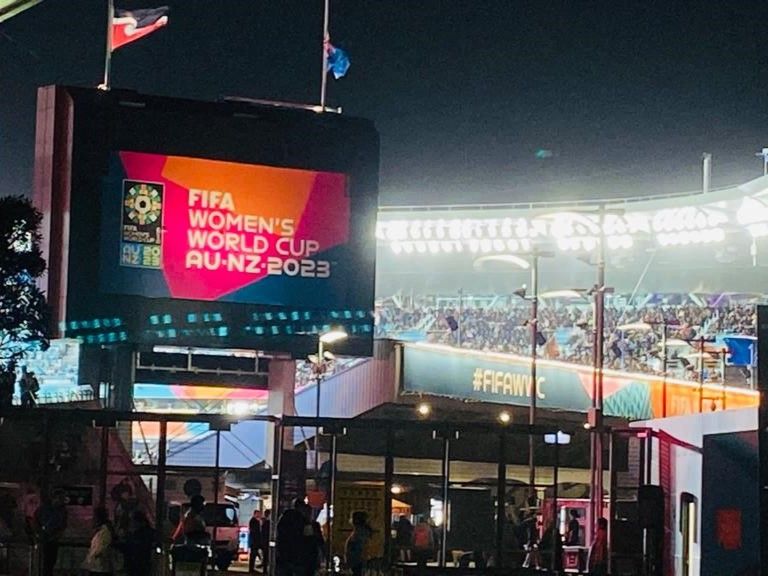Crowdguard scores for HVM match day security at Women's World Cup venues

Crowdguard is no stranger to delivering counter terrorism protection for stadiums or risk assessing major matches, but recently we took on the brief for a major football tournament in New Zealand, which involved the increased threat and added scrutiny of a globally important event.
Our brief was to risk assess four stadiums in New Zealand – Eden Park in Auckland, Waikato Stadium in Hamilton, Forsyth Barr Stadium in Dunedin and Sky Stadium in Wellington – to advise on proportionate counter terrorism protection for fixtures at each venue throughout the tournament, provide and deploy HVM equipment at each location, and train local teams in deployment and supervision of the kit.
Our Counter Terrorism & Risk Director, Russ Phillips, travelled to New Zealand three months before the start of the tournament to carry out a threat, vulnerability and risk assessment at each location, working with the tournament’s management team, the venues and local police forces to develop a clear proposal for each stadium. The proposal had to take account of the high profile of the event, the operational needs of each stadium and the specific threats and vulnerabilities for each location.
Russ explains: “Locally, the threat level had been assessed as ‘low’, but we were concerned about the significant underlying threat presented by a high profile global event of this nature. Working collaboratively with local stakeholders, our role included educating those responsible for the tournament, the venues, and match day security about the role that HVM can play in protecting people and assets from malicious vehicle attacks. We also discussed with them the holistic nature of a counter terrorism plan and the need to focus on proportionate protection of the most vulnerable locations at the most vulnerable moments before, during, and after each match.”
The risk assessments concluded that it would not be proportionate to install HVM equipment at the stadium in Wellington, because 75% of the audience would not need to be near any vehicle access routes at any point at that venue, and egress to the train station at the end of each match was within the footprint of the stadium. For each other the other stadiums, however, Crowdguard submitted a proposal that included supply and shipping of HVM systems, training of local deployment teams, supervised installation and quality assurance checks.
At Eden Park in Auckland, Crowdguard worked with the stadium and the traffic management provider to implement a hostile vehicle mitigation strategy that took into account the venue’s operational requirements and predictable crowd movements in the lead up to each game and the following the final whistle. Trained operatives installed 56m of ATG Surface Guard in three locations, one with pedestrian permeability only, and the other two with vehicle access units for blue light services and authorised vehicles. In a fourth vulnerable location, 12m of ARX Stopper!™ was installed to protect pavement areas while maintaining excellent flows of foot traffic, and 10m of Highway Care Security’s RB50 was deployed across the carriageway to prevent vehicle incursions while enabling the flexibility to allow authorised vehicles through.
HVM protection was also deployed in four locations at Waikato Stadium in Hamilton, in response to the threat, vulnerability and risk assessment, and traffic management plans. Here, a total of 38m of ATG Surface Guard was deployed across two locations, each with vehicle access units to protect ticketed entry points to the ground. In a third location, the Crowdguard team deployed ARX Stopper!™, protecting 15m of carriageway and pavement, and in the fourth location, 11m of RB50 was installed to protect against vehicle attacks, while enabling rapid access for team coaches and VIPs.
Finally at Forsyth Barr Stadium in Dunedin, HVM equipment was deployed in three locations, which all needed pedestrian permeable protection with vehicle access for emergency services. To answer these requirements, the Crowdguard team installed 55m of ATG Surface Guard across the three locations.
For all three of the stadiums that required HVM equipment, the installation had to take account of specific and mission critical operational requirements. Pedestrian permeable HVM equipment installed on pavements remained in-situ throughout the tournament, but all equipment installed on carriageways was deployed prior to each fixture (of which there were 20 during the tournament across these three venues) and derigged after crowds had dispersed following each match. At one of the stadiums, the location of the HVM equipment also had to take into account the vehicle movements for a local quarry, which had to continue as normal at all times.
Around 200m of equipment was shipped across to New Zealand for the project in three containers, and Crowdguard site supervisor, Andy Ferris, was responsible for storing and checking the kit, as well as training the local teams, deployment of the correct equipment to each location at the right time, and quality assurance checks.
Andy adds: “I was over the moon to be sent to New Zealand for work and it was a fantastic experience, but it was also very demanding. I had to build a rapport with local deployment teams very quickly to ensure that they were trained up for the project and capable of installing the kit to the high standards we require. I was also responsible for co-ordinating all the equipment and making sure the right units were available when and where they were needed.
“The lionesses were not the only Brits that caused a stir down under. The way we approached the brief from risk assessment through to de-rigging after the last match is really something we can be very proud of.”
)
)
)